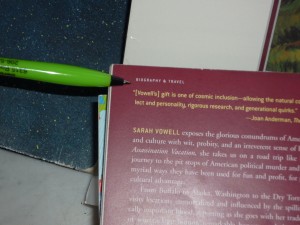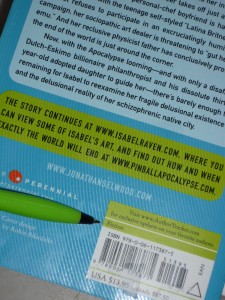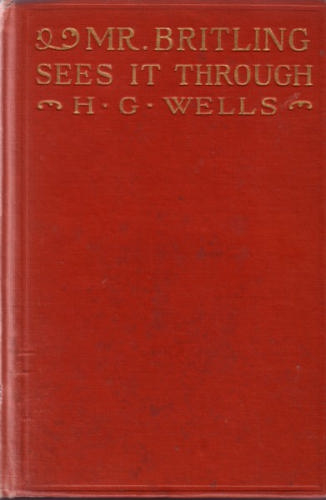
Before I launch into today’s wit and wisdom, a bit of shameless promotion on behalf of a long-time FAAB (Friend of Author! Author!): the ever-fascinating Mary Hutchings Reed, author of COURTING KATHLEEN HANNIGAN is the featured interview on Women’s Radio’s Your Book is Your Hook. In this radio interview, Mary talks about an issue dear to all of our hearts, successfully marketing one’s own novel. She and other authors also write on the subject at the YBIYH blog.
Okay, back to the business at hand. We begin today’s foray into the realities of publishing with a parable.
I was in a jam-packed coffee shop mid-morning, chatting with a photographer friend of mine. It’s a local mommies’ haunt, so the air was shrill with childish exclamations of joy, outrage, and pay-attention-to-me-now. My much-belated Christmas present to the photographer, a fragile bobble, was wrapped, bubble-wrapped, and in my purse; since the shiny red bow was peeking out, I prudently tucked the purse under the hem of my long skirt whenever children were playing with the contents of the nearby toy box.
You can feel the crisis coming, can’t you? That’s what we in the biz call suspense.
Several three- to five-year-olds were marauding the box when I felt my skirt move beneath me. Before I could shield my purse, a wee pickpocket had nabbed the present and was running away with it, screaming, “Mommy! Christmas!”
Being longer of arm than he was of leg, I was able to snatch the box back before it went smashing to the floor. “No,” I told the miniscule would-be pirate in gentle-but-firm tones, “please don’t take that.”
Naturally, he darted off to tell his mother all about it — probably not flatteringly, as she began glaring at me from the coffee line, twenty feet away. Continuing my interrupted conversation, I gradually noticed a small, terrified figure frozen in my peripheral vision. Another toy box marauder covered his mouth guiltily, as if he expected me to scold him.
Taking in the situation at a glance, as the omniscient narrator of many a late 19th-century novel would say, I hastened to comfort him. “It’s okay — I wasn’t talking to you. You didn’t do anything wrong. Go ahead and play.”
After several soothing iterations, he seemed to calm down. Either that, or the Transformer teetering on the top of the toy pile was more attractive and interesting than I was. Rejection happens to the best of us.
A full two minutes of apparently absorbed play later, Moppet #2′s mother showed up with coffee, stroller, and baby sister. Promptly, the little boy burst into tears, clambered into her lap, and began wailing that he was too scared to play. Amidst the rising hysteria, I could discern only two repeated words: “mean lady!”
Now I had two mothers glaring at me. As the child sobbed, the mother murmured, “I won’t let her hurt you,” and the photographer laughed, I tried to explain what had happened. Without a word to me, Mommy scooped up the increasingly incoherent child and stomped off to a table on the other side of the coffee shop, presumably to distance herself and her brood from my negative aura. The first mother made a point of walking over and introducing herself. For the next hour, nasty glances and reiterations of “I won’t let her hurt you, honey.” passed from their table — yes, the moms joined forces — to ours.
Why am I bringing this up, other than as an explanation of why I don’t tote my laptop to nearby coffee shops as often as I otherwise might? Because even as this story played out, I said to myself, “Wow, this is how a good third of the aspiring writers I know initially reacted to learning how the publishing industry works.”
Yes, seriously. Bear with me here.
Kid #1 is the writer who leaps into approaching agents — or, sacre bleu, editors at publishing houses — without doing his homework: he sees something he wants, so he grabs for it. He doesn’t know better: he calls the agency to pitch directly; he e-mails 45 identical boilerplate queries; he sends an unsolicited manuscript.
And when any of those 45 agents or editors says no, he concludes not that there might be rules he doesn’t know about, but that she’s just mean and withholding.
Kid #2, by contrast, is the writer so terrified by everything he’s heard — on the Internet, at writers’ conferences, from fellow writers — about the perils of rejection that he simply worries himself to a standstill. He wants to play with the toys (which are, after all, there in the box for his enjoyment), but he’s scared of someone yelling at him if he makes the effort. He might do something wrong, and thus blow his chance. Just look at what happened to that other kid!
So he waits for someone in authority to tell him that what he wants to do is okay. And then, like so many aspiring writers who have worked up the courage to query or pitch and have received requests for pages, he loses his nerve.
Far, far less risky to complain vociferously about how genuinely scary the situation is than to stick out his neck solo. Some Millicent might scold him if he tried.
I can’t work the two moms into the metaphor; sorry.
My point is, for both kids, the mere fact that someone they didn’t know was enforcing a rule was intimidating, even if the adult laying down the law was someone as soft-spoken as yours truly. I’m not precisely the type whose approach makes dogs and small children whimper, if you catch my drift, but limits are startling, especially when you’re new to the game.
If you didn’t know that a fence was there until you ran right into it, the shock is substantial. It hurts almost as much as the bump the fence post gave your head.
That doesn’t mean, however, that the fence was out to get you, any more than the lady who doesn’t want you to steal from her purse is mean. Every type of human interaction has its own set of rules, and the sooner a person learns them, the sooner he can learn not to react to impersonal barriers as though they were personal attacks.
On a not entirely unrelated note, last time, I broached the burning question at the front of the mind of every writer who has ever submitted a manuscript to an agency: how soon will the agent make a decision about whether to represent my book?
The answer, pretty much invariably, runs a little something like this: not as quickly as the writer would like.
And that reality, like the excellent life axiom Do Not Lift Things From Other People’s Purses, is applicable to everyone, not just oneself. Try not to take slow turn-around times personally — or as any reflection whatsoever upon the quality or marketability of your writing.
It’s just the way the system works. And no, that present in my bag is not for you, kid.
Don’t believe me? Or, more likely: believe me rationally, but can’t accept it emotionally? Let’s analyze the situation.
Tell me again why the submission process seems to take so long?
As we discussed in the previous post, agents don’t draw out the submission process just to torture writers — the delays in turn-around are often due to logistical considerations, such as the number of screening levels though which a manuscript must pass prior to the agent, how backlogged the agent’s reading schedule is (remember, she doesn’t just need to peruse new clients’ books; her existing client list keeps producing manuscripts, too), and the sheer volume of submissions an agency receives.
Oh, and people who work in agencies have lives too; no one, however dedicated to literature, reads 24 hours per day, 7 days per week, 365 days per year plus one in leap year.
As much as impatient writers might like them to do so. Or to believe that any delay in hearing back, however minute, could only be explained by the agent’s reaction to the manuscript.
But that’s almost never true. Despite the fact that aspiring writers tend to be very, very gifted at manufacturing creative reasons that they haven’t yet received a response after submitting requested materials, the usual reason is quite prosaic: if you haven’t heard back about a submission, chances are that the people at the agency who need to read the manuscript just haven’t had time to get to it yet.
Or at least, as is often the case, haven’t read beyond the first few pages. But believe it or not, when an agent skims the opening of a manuscript and sets is aside to read more closely later, that’s actually good news, from the writer’s perspective. Even if the submission subsequently gathers dust and coffee stains on the corner of his desk, its author has reason to rejoice.
Why? Well, contrary to popular belief, agents and editors will seldom read an entire manuscript before deciding to reject it. Once they come to a page (or paragraph, or even sentence) that raises a red flag, they generally stop reading altogether.
In fact — and you might want to sit down for this, if you’re new to this blog — it’s very, very common for submissions to get rejected before the bottom of page 1. One frequent flag-raiser: wildly unprofessional presentation; in case you’re not aware of it, there is a standard format for book manuscripts (explained in great detail in the posts under the HOW TO FORMAT A MANUSCRIPT and STANDARD FORMAT ILLUSTRATED categories at right).
I can sense some resistance to the concept of quick rejection floating out there in the ether. “But Anne,” dewy-eyed idealists everywhere exclaim, “that can’t possibly be right. No one seriously interested in writing would dismiss a book without reading it. They’ve got to give it a fair chance. If an agent asks to see my manuscript, of course he’s going to take the time to read it!”
Oh, my dears. The explanation is going to be even harder for you to accept than what has already raised your hackles, I’m afraid.
The front-loaded submission screening process
Rejected manuscripts rarely read in their entirety, for the exceedingly simple reason that if a manuscript has problems throughout — anything from clichèd dialogue to grammatical errors to lack of excitement on the page — it tends to show up within the first few pages. Or at least within the first fifty.
Which is why, in case anyone was wondering, agents so often ask for fifty pages. Or the first chapter. Millicent the agency screener assumes — and so does her boss, and so will an editor — that if the writing has problems or the story is weak early on, it will remain so for the rest of the book.
Are you thinking that aspiring writers who take a while to warm up are out of luck? Good; you’re beginning to understand how the system works. And that, my friends, is a significant advantage.
How? Being aware of how front-loaded the submission process is enables a writer intending to submit to edit those opening pages so that at least some of the book’s best writing appears first, as well as prompting a special care to avoid rejection triggers there.
Again, not entirely coincidentally, here at Author! Author!, we tend to spend quite a bit of our energy on how to identify and excise these manuscript red flags. For an intensive analysis of dozens of the most common rejection reasons and tips on avoiding them in your submissions, please see the HOW NOT TO WRITE A FIRST PAGE category on the list at right.
Back to that good news I mentioned above: if an agent reads the first few pages of a submission and sets it aside to peruse later, that means he hasn’t rejected it; unlike the overwhelming majority of submissions, its opening passed muster. Hooray!
Insofar as a submission’s sitting on an agent’s bedside table for three months can be a hooray-inducing situation.
I’m sensing more disturbance in the ether. “Okay,” the idealists concede reluctantly, “I can see how rejection might be a speedier process than acceptance. But if the agent (and his Millicent who screens things for him) makes up his mind that quickly about most rejections, does his setting my manuscript aside to read later mean that he’s already basically decided to accept it?”
Oh, would that it were that simple. Once a manuscript has cleared the instant rejection hurdle, many other criteria come into play.
What makes an agent decide to take on one manuscript, rather than another, when both have been sitting on the edge of his desk for the past three months?
One reason, and one reason only: she believes that she can sell the first book in the current literary marketplace. Period.
In other words, in her professional opinion, not only is the book is well-written and might interest people who buy and read books, but she also has the connections to editors at major or mid-sized publishing houses who will be interested in bringing this particular manuscript to publication. Furthermore, she believes that the book concept and presentation are polished enough that she can begin sending it out to editors without having first to invest tremendous amounts of her time in re-editing the work. Also, based upon how the writer has presented the manuscript and handled the querying/pitching and submission process, she believes that the writer is sufficiently professional and well enough versed in how publishing works that she will not need to hold his hand throughout every step of the process.
Makes you want to run crying to your mother, doesn’t it?
Idealists’ hands just shot up all over the English-speaking world. “But Anne, this extremely complicated set of conclusions is, you must admit, hardly likely to be something an agent is likely to reach on a purely spontaneous basis three lines into the manuscript! So how can Millicent possibly reject any manuscript on page 1?”
Rather easily, as it happens — you wouldn’t believe how many submissions contain major grammatical or logic errors on page 1. But you do have a point, idealists: even for the minority (and it is a minority, alas) with impeccable opening pages, Millicent needs to see more than just a technically correct, clearly-written, genre-appropriate manuscript: she is looking for something that will grab her boss.
In other words, most agents require far, far more reasons to accept a manuscript than to reject it. Just good, or even good and marketable, is seldom good enough to land an agent.
Quash the impulse to throw a toy at the mean lady who is telling you the rules, please. She didn’t make them.
In order to come up with that array of pluses, the agent will need to spend some time getting to know the book. However, that doesn’t necessarily mean that she will be reading it with a charitable eye. Remember, reputable agents only make money if they can sell their clients’ books: she can only afford to take on what she’s confident she can sell.
So since even an extremely successful agent can take on only a few new clients per year — especially in this economy — in practice, agents considering a new client typically read with an eye peeled for reasons not to take on the book.
Yes, even for that tiny percentage of submissions that make it past Millicent. As an agent of my acquaintance likes to say, he scours the first 185 pages of a submission from a would-be client eager to find reasons to reject it. After he’s invested the time to read up through page 185, then he starts looking for reasons to accept it.
Those reasons will not necessarily be purely literary, or even aesthetic, mind you. Agenting is, after all, not a non-profit enterprise devoted to the cause of art for art’s sake, but a business.
The choice to sign a client, then, is very seldom purely the result of the agent’s just falling in love with the book at first sight — although rejection often does come that quickly. She may well fall in love with it eventually, but it’s a more mature, reasoned sort of love, the result of a considered decision, not a gut impulse.
I’m bringing this up because often, the underlying assumption behind the “But what’s taking so long?” cri de coeur is not just the mistaken belief that an agent who requested materials will drop everything in order to read them the moment they arrive, but also the misguided theory that if a book is compelling, the reader won’t be able to put it down until she finishes reading it.
Trust me, people who read manuscripts for a living manage it. All the time. If they couldn’t, they’d never be able to leave work at the end of the day or go to sleep at night.
And you know how Millicent needs her beauty sleep.
Another frequent submitter’s assumption is that good writing is inherently so arresting that any professional reader worth her salt should be able to identify an exciting new voice instantly, practically from the top of page 1. While it is often the case that good writing will make professional readers think, “Wow, I’m looking forward to reading on!” that does not mean the initial tingle of hope should be confused with the ultimate decision to represent the book.
The former merely means that the latter outcome is possible, not that it is guaranteed. That possibility is what keeps Millicent — and her boss, if a submitter is lucky — turning pages.
Thus, the secret writerly fantasy about a literary agent’s taking one look at a query letter or hearing a pitch and crying, “STOP! I don’t need to know anything else! I must sign this writer immediately!” just doesn’t happen in real life. (Well, okay, so it does happen to the occasional celebrity, but I’m guessing that if any of you were already famous and/or internationally disreputable, my blog wouldn’t be the first place you would look to find out how to seek representation.) A reputable agent is going to want to read the manuscript in its entirety before making up her mind — or, for nonfiction, the entire book proposal.
Yes, no matter how stellar the book’s premise may be or how good the writer’s credentials may be for writing it. Many a marvelous idea has been scuttled by poor presentation. As they like to say in the industry, it all depends on the writing.
Yet that truism is a trifle misleading, because — and this would be a good time to reach for your inhaler, if you’re prone to stress-induced asthma — writing quality alone is not necessarily enough going to be enough to charm an agent into agreeing to represent a book.
Yes, the agent generally has to like the writing, find the premise appealing, regard the characters as well-rounded and believable, and so forth, but since she will have to make a substantive argument to an editor about how this manuscript is different and better than both similar books already on the market and the other manuscripts the editor is likely to see anytime soon, she does need to pay close attention to the book’s selling points over and above the beauty of the writing.
Including, incidentally, whether the manuscript is the kind of book that’s selling right now. Not what is currently featured in bookstores at the moment, but what editors are buying now.
Trends: sometimes the writer’s enemy, sometimes friend
As we discussed earlier in this series, there’s generally at least a year between when a publisher acquires a book and when it’s released, so what consumers may buy today is actually a reflection of what editors were buying 12 or 15 months ago, possibly more.
This fact is crucial for aspiring writers to understand, as it has a huge effect on the marketability of their manuscripts, from an agent’s perspective. Since the book market is notoriously susceptible to trends — ask anyone who happened to be trying to sell a vampire romance immediately after the TWILIGHT series hit the bestseller lists, or anyone attempting to market a memoir just after the A MILLION LITTLE PIECES scandal broke — agents’ self-protective attention to what is selling now, as opposed to 5, 15, or 100 years ago, often means that a manuscript that would have experienced little difficulty finding representation in another year might seem like too big a risk to for an agent to take on now, and vice versa.
Yes, you are understanding me correctly: from an agent’s point of view, a good book is not necessarily a marketable book — and a book that is marketable today is not necessarily what will be considered especially marketable six months or two years from now.
Which is why, in case those of you who have attended writers’ conferences recently have been wondering, some agents are prone to telling rooms full of gaping aspiring writers, “Oh, no one is buying that kind of book anymore.” They don’t mean that the specified type is never going to sell again — they mean that there isn’t a particularly strong demand for it amongst editors at the major houses right now.
But as an honest agent will be the first to tell you, no one can possibly say for sure what will be selling well next year. Especially given current market conditions.
So when aspiring writers complain about how books like theirs are not finding agents these days, it’s unlikely to strike anyone affiliated with the publishing industry as a searing indictment of their collective aesthetic judgment, but rather as a simple statement of fact about the current literary market. That some types of writing will fall out of fashion from time to time is inevitable; that ones that were not hot in the past will become so is equally inevitable.
And if that fact makes you want to tattle on agencies, rather than sending out another flotilla of queries next month, or renders you immobile with horror at the prospect of mailing the book you’ve spent the last three years writing to an agent who routinely dismisses excellent manuscripts because he cannot expect to sell them, well, you’re like most aspiring writers.
Specifically, like the ones who become convinced that a handful of rejections can only mean that their manuscripts are no good. Or the ones that never work up the nerve to query or submit at all.
If, on the other hand, your first response was, “Wow, it sounds like Anne’s spouting that old truism about the weather, if you don’t like it, wait a minute,” then congratulations: you’re catching on to how publishing works.
See why it’s so vital to a writer’s continued happiness not to take the vagaries of the literary market personally? Don’t let the rules of the coffeehouse frighten you away from that toy box; it’s there for creative people like you.
Keep up the good work!
























